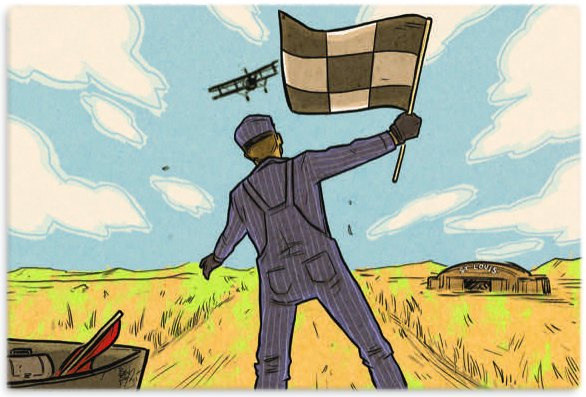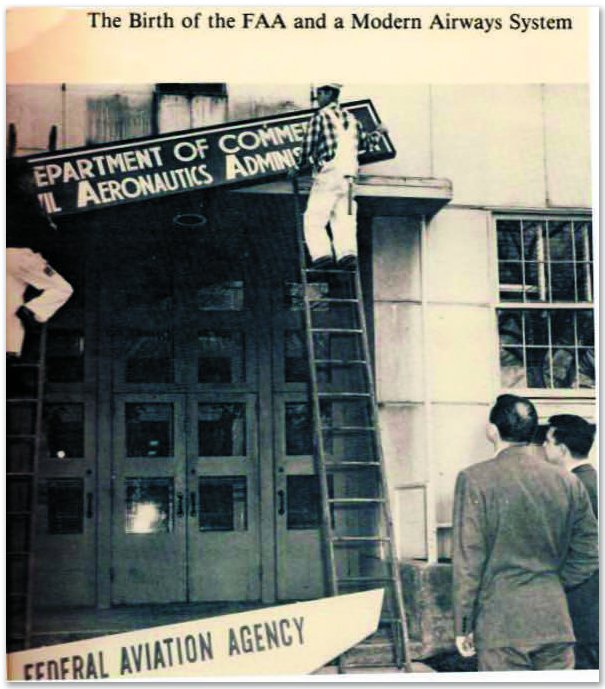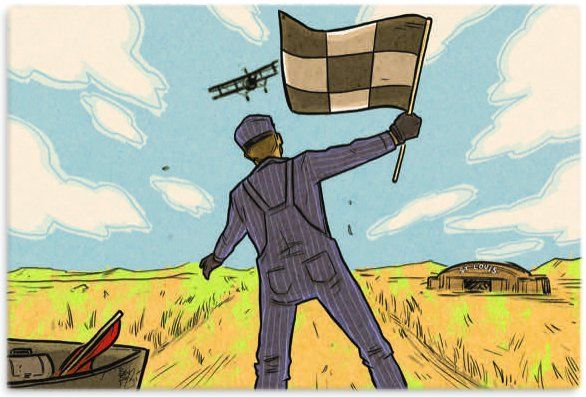Which came first: the chicken or the Federal Egg Administration? Impossible to say. Physics teaches us that when Bernoulli found lift, his nemesis, Newton, said there must be an opposing reaction. So, when the Wright brothers flew, government pondered how to keep them from impacting all those other aeronauts. Little happened because of Newton’s Law of Administrative Inertia: An agency at rest remains at rest until acted upon by an un-ignorable force.
The growth of air traffic control (ATC) followed a predictable path: Innovation (private sector), befuddlement (government), punctuated by periodic disasters, followed by outcry and government reaction. Repeat. Today’s National Airspace System (NAS) and its ATC components are the outgrowth of screw-ups, miscalculations and clever winging it.

Art By Ben Bishop
Meet Me in St. Louis
During the Great War (which wasn’t that great; we can do better), belligerents embraced aviation’s potential but, by adding machine guns, made it self-limiting. When the war to end all metaphors concluded, survivors embraced aviation’s commercial value—hauling mail, nauseated passengers, and bootleg liquor.
As air traffic increased, the Department of Commerce was charged with putting order to this nascent industry growing faster than politicians could say, “Whatever it is, I’m against it!”1 The Air Commerce Act of 1926 created the Bureau of Air Commerce, which decided who got to fly where and when. Airlines multiplied like pimples on prom night and muscled into airport traffic patterns where confusion reigned. Until Archie.
St. Louis, MO was a pioneer aviation hub—its “Spirit” took Lindbergh to Paris in 1927. With so many airplanes, the concepts “near miss” and “mid-air” took shape. Pilot and mechanic Archie League mitigated unruly patterns when, in 1929, he rolled a wheelbarrow to runway’s end. Inside were his lunch box and two flags. Red flag: Hold. Checkered flag: Cleared for takeoff/landing. Thus, he issued the first ATC clearance and became the first air traffic controller to work through his meal break, planting unionization seeds.
Flags are fine on clear days—not so much at night or in fog. Enter the control tower with light signals and bright beacons. Radio was added in Cleveland, OH in 1930.
With the advent of gyro instruments, pilots could fly inside clouds, following a low-frequency A and N, four-course range. Lighted airway beacons and radio markers indicated reporting points. Nice, but impractical, since every airliner wanted to follow the same routes at the same time with the result that in the early 1930s about 12 domestic air-carrier collisions were reported per year.
Congress was slow to react until Senator Bronson Cutting was killed in a DC-2, low on fuel and scud-running at night toward destiny. Tragedy spawned a conference in 1935 at which Edgar Gorrel, of the Air Transport Association, established GA’s place in the IFR world: “Private flying is today a menace….” Without objections, the airlines created an air traffic control consortium and agreed to share flight plan information and coordinate departure times, routes and altitudes.
The first Airway Traffic Control Station opened in Newark, NJ in 1935. Air traffic controllers were called Flight Control Officers. Run by the airlines, these enroute centers, as they would later be known, expanded into Cleveland, Chicago and Pittsburgh. In 1936 the Bureau of Air Commerce took control of centers. A year later Washington, DC, Los Angeles and Oakland Centers opened. Atlanta, St. Louis, Salt Lake City and Fort Worth opened in 1939, and in 1941 Seattle and Cincinnati joined the list.
Separation Standards Evolve
Vertical separation of traffic is simple: Keep users at different altitudes, and no one hits. Problem is, no one lands. So rules were developed to allow altitude changes based on position reports, much like today when ATC says, “Radar service terminated (or lost), report FIGBY.”

Radar wasn’t common until 1940 when the British were dealing with German air traffic over London. Before radar—which really didn’t make the ATC scene with great effect until the 1960s—controllers hovered over maps and plotted airliner progress as dispatchers phoned in position reports. Direct pilot-to-center radio communication wasn’t available until 1949.
Controllers tracked aircraft progress with small “shrimp boats” pushed across the map. Each represented an airplane and had a clip holding a slip of paper with the call sign and altitude. Shrimp boats would serve well into the radar age on flat-top radar displays. Before digital data tags, controllers wrote aircraft data on the plastic data tags and gently nudged them across the scope.
Additionally, each flight had a flight progress strip with more information. By stacking these strips, early controllers formed the 3-D picture, and to some extent their descendants still do.
Once an aircraft passed a fix, another at the same altitude could also pass. If two were approaching the same fix at the same altitude, the controller could instruct one to climb or descend before a certain point or stop one in a holding pattern until the airspace was clear.
This is easy where flight paths cross at right angles, but someone had to figure how much room was needed to protect these converging points based on all the possible converging angles. There was no ATC manual until the controllers wrote it.
Non-radar separation gets muddier when two—or more—airplanes are at the same altitude on the same route, especially if the trailing aircraft is overtaking. In the 1930s, in-trail separation was at least 10 minutes. The moving math of non-radar air traffic separation rapidly developed out of necessity, and safely remains the basis of separation standards today. If a 2017 approach controller loses radar, traffic gets slapped onto airways and separated by altitudes, routes and speed as pilots stumble making position reports and estimates to subsequent fixes.
In 1940, the newly created Civil Aeronautics Administration (CAA) took over ATC. By the time the U.S. entered WWII in 1941, the CAA ran 24 enroute Centers with 4000 employees. By war’s end, the CAA had 7800 air traffic controllers.
Postwar Boom
Peace brought a surge in civil aviation. Former military pilots transitioned into the airlines. Non-pilot veterans learned to fly under the GI Bill, which meant more airplanes being built and more airliners reaching new markets. DC-3s gave way to DC-6s and Lockheed Constellations (Connies), flying higher, faster and stretching ATC resources. From 1949 to 1955 airline passenger traffic doubled, even as CAA staffing levels were cut. In 1955, the DC-7 premiered, capable of flying non-stop from the U.S. to Europe, carrying 100 passengers at 300 knots.

More traffic in an overburdened and underfunded ATC system with little radar service, meant midair collisions and near misses occurred at uncomfortable rates. On June 30, 1956, a United DC-7 hit a TWA Super Connie at 21,000 feet over the Grand Canyon, killing all on both airliners. Post-accident fingers pointed, politicians ha-rumphed, but the public demanded change—to what, most didn’t know. In short order, Congress funded the CAA to increase the number of VORs, purchase 82 advanced long-range radars and install an IBM 650 digital computer at Indianapolis Center, and should the computer thing work out, buy more. The modern ATC system emerged from the Grand Canyon ashes. Except, while the CAA met challenges posed by DC-7s and Super Connies, Boeing took orders for its 707 and Douglas for the DC-8. ATC needed to adapt faster, before TWA and United could meet again.
The Jet Age
Ground speeds suddenly reaching 600 knots changed everything, with airlines leading the way and the CAA playing catch-up. In December, 1957 CAA classified all airspace above 24,000 feet as Continental Control Area with a dozen “super skyways” planned for transcontinental commercial traffic. With no private jets, this was primarily for airlines.
By 1958, 707s and DC-8s were in service, each capable of hauling 189 passengers. The same year recorded three notable mid-air collisions. The first occurred when an Air Force C-118 (DC-6) collided with a Navy P2V patrol bomber over Los Angeles, killing 50. The second midair was near Las Vegas when an Air Force F-100 Super Sabre cut through a United DC-7 at 21,000 feet, leaving 49 dead. The third collision again mixed civilian and military when a VFR Air National Guard T-33 trainer collided with an IFR four-engine turboprop Capital Airlines Viscount over Maryland, killing 61.
A day after the Maryland midair, Senator Mike Monroney from Oklahoma, introduced the Federal Aviation Act, which—among other things—created the Federal Aviation Agency (FAA). President Eisenhower signed it into law on August 23rd, proving that government can move quickly when the body count gets embarrassing.
The FAA was charged to oversee and regulate everything in aviation. The first administrator was retired Air Force General Elwood R. Quesada, who rolled into office kicking butts and making changes. But it took another midair to spark the next airspace upgrade.
Past and Future Collide
Mid-morning December 16, 1960 brought low ceilings and snow to New York City, as a TWA Super Connie was cleared for the ILS approach into LaGuardia Airport. Heading into Idyllwild Airport (now JFK) was a United DC-8. The last of the piston airliners and first of the jets met over Staten Island when the DC-8, not in radar contact and traveling in excess of 300 knots, overshot its holding fix. Essentially, the United crew was lost and navigating with one VOR receiver, the other being inoperable. Radar service and visibility were minimal—TWA was on a New York approach radar scope, but United was not. One of United’s engines scooped through TWA’s cabin, dropping the Connie onto Staten Island. United continued toward Idyllwild as the crew steadily lost control of the damaged DC-8, until it slammed into the Park Slope neighborhood in Brooklyn, where all onboard United plus eight on the ground, died.
Once again, out of tragedy came reforms: IFR pilots must inform ATC of navigation or communications failures. Turbine-powered aircraft must have distance-measuring equipment (DME). ATC improved its radar hand-off procedures. Finally, no aircraft could exceed 250 knots below 10,000 feet.
1960s and Beyond
ATC continued to improve in the next decade as more jets (B-727, B-737, B-747, DC-9, Lears…) entered service and competed for airspace. Despite progress, airliners still crashed, and in 1965, a TWA B-707 hit an Eastern Airlines Connie over Carmel, NY. Both were approaching the Carmel VORTAC when the crews saw each other. Although separated vertically by 1000 feet, the illusion created by the upsloping cloud tops, caused the 707 pilot to think they were converging, so he banked to steer clear. Instead, they hit. Amazingly, TWA limped safely into JFK, while Eastern’s crew lost all control. By playing the throttles, the pilot was able to crash land the four-engine Connie in a level attitude, minimizing fatalities.

The 1960s saw the arrival of ARTS (Automated Radar Terminal System), which put digital tags on radar displays. Adios, shrimp boats (although they were kept as backup). ATC was improving and catching up with the users. Controllers slowly received better equipment and even a pay raise.
In 1967 the newly created Department of Transportation (DOT) renamed the Federal Aviation Agency as the Federal Aviation Administration. Despite the name change, airplanes still collided, including a TWA DC-9 descending into Dayton, OH and a VFR Beech Baron, prompting the creation of Terminal Control Areas (TCA, the precursor of Class B airspace) around busier airports.
Three years later, transponders were required to operate in TCAs. Midair collisions declined, suggesting the FAA was gaining ground. But another problem awaited—air traffic controllers grew actively dissatisfied with FAA management. In 1968, a handful of New York controllers formed the Professional Air Traffic Controllers Organization (PATCO). In six months, membership grew to 5000.
While organizing controllers didn’t have a direct input on air traffic, FAA management was slow to understand controllers’ gripes. PATCO sickouts, however, did affect traffic, as controller/management relations soured, and so began a decade of ATC labor unrest, erupting on August 3, 1981, when 13,000 air traffic controllers walked off the job and brought IFR traffic to a crawl.
It appeared in the early hours that PATCO had triumphed, but the FAA had learned from the earlier sickout and was prepared to react. Of the controllers who walked, about 850 returned during a brief grace period. The others were fired, and the FAA began the slow process of reinventing the air traffic system…again.
Repeat
Post-strike ATC would seem to have been in total ruin. Some would disagree, but between late 1981 and today, the FAA managed to restart the stalled system, with a limited workforce and new hires beginning the difficult process of replacing the fired controllers. Those 11,000 lost employees were highly experienced with no available replacements. The economy was in recession, which reduced demands on ATC. This breathing space scared Congress into funding not only to rebuild the NAS but point it toward the future. Goodwill hugs were everywhere, and, eventually, the FAA squandered that to some extent.
From the 1981 rubble came the impetus to radically change how we navigate. It’s been a slow slog from ground-based navaids to satnav. GPS is nearly as important to aviation today as Bernoulli’s “So that’s how lift works” moment in the 18th century. Federal airways designed for DC-2s, might find a place in Smithsonian’s Air & Space museum, while GPS makes creative routing a reality.
Elsewhere, ATC radar service—including backups—improved. Simultaneous parallel approach operations funneled even more traffic into saturated airports. Weather radar, including NEXRAD, and wind shear detection improved throughout the 1990s. Still, pilots blundered into thunderstorms, and still they near-missed and occasionally collided, such as the 1986 Cherokee and DC-9 midair over Cerritos, CA. Again, from tragedy springs regulation, which increased use of Mode C and TCAS.
While progress was relatively swift after PATCO’s demise, the FAA slipped back into its labor-management ways, leading to the formation of NATCA (National Air Traffic Controllers Association) in 1987, which must’ve had PATCO ghosts howling, “Told you so….”
ATC’s future is bright(ish). ADS-B is reality and will continue to revamp NAS and our places within it. And there, beneath the technological and procedural improvements, lies the ATC foundation first established when Archie League waved his flags in 1929. And as the propeller of ATC progress turns, we, inevitably come full circle.
The first enroute air traffic facility was run by the airlines in 1935. Today, the stench of ATC privatization—largely controlled by the airlines—is again in the air. Perhaps the prescient words of Edgar Gorrel, of the 1930s Air Transport Association, might augur our future: “Private flying is today a menace….” Time, once again, to decide if we’re the chicken or the egg about to be scrambled.
The author wishes to thank Mr. Ron Fandrick for his excellent website covering the history of ATC, rwf2000.com/atc, which simplified a lot of the research necessary for this article.
Paul Berge, CFII, is an IFR editor emeritus and author of Private Pilot Beginner’s Manual (for Sport Pilots, too). Additional information at paulberge.com.





